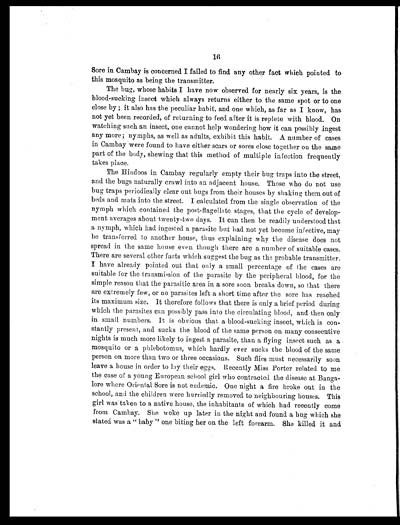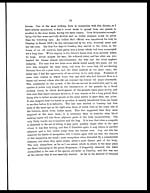Medicine - Institutions > Army health reports and medical documents > Scientific memoirs by officers of the Medical and Sanitary Departments of the Government of India > Number 50 - Preliminary report on an investigation into the etiology of Oriental sore in Cambay > Preliminary report on an investigation into the etiology of Oriental sore in Cambay
(26) Page 16
Download files
Individual page:
Thumbnail gallery: Grid view | List view

16
Sore in Cambay is concerned I failed to find any other fact which pointed to
this mosquito as being the transmitter.
The bug, whose habits I have now observed for nearly six years, is the
blood-sucking insect which always returns either to the same spot or to one
close by; it also has the peculiar habit, and one which, as far as I know, has
not yet been recorded, of returning to feed after it is replete with blood. On
watching such an insect, one cannot help wondering how it can possibly ingest
any more; nymphs, as well as adults, exhibit this habit. A number of cases
in Cambay were found to have either scars or sores close together on the same
part of the body, spewing that this method of multiple infection frequently
takes place.
The Hindoos in Cambay regularly empty their bug traps into the street,
and the bugs naturally crawl into an adjacent house. Those who do not use
bug traps periodically clear out bugs from their houses by shaking them out of
beds and mats into the street. I calculated from the single observation of the
nymph which contained the post-flagellate stages, that the cycle of develop-
ment averages about twenty-two days. It can then be readily understood that
a nymph, which had ingested a parasite but had not yet become infective, may
be transferred to another house, thus explaining why the disease does not
spread in the same house even though there are a number of suitable cases.
There are several other facts which suggest the bug as the probable transmitter.
I have already pointed out that only a small percentage of the cases are
suitable for the transmission of the parasite by the peripheral blood, for the
simple reason that the parasitic area in a sore soon breaks down, so that there
are extremely few, or no parasites left a short time after the sore has reached
its maximum size. It therefore follows that there is only a brief period during
which the parasites can possibly pass into the circulating blood, and then only
in small numbers. It is obvious that a blood-sucking insect, which is con-
stantly present, and sucks the blood of the same person on many consecutive
nights is much more likely to ingest a parasite, than a flying insect such as a
mosquito or a phlebotomus, which hardly ever sucks the blood of the same
person on more than two or three occasions. Such flies must necessarily soon
leave a house in order to lay their eggs. Recently Miss Porter related to me
the case of a young European school girl who contracted the disease at Banga-
lore where Oriental Sore is not endemic. One night a fire broke out in the
school, and the children were hurriedly removed to neighbouring houses. This
girl was taken to a native house, the inhabitants of which had recently come
from Cambay. She woke up later in the night and found a bug which she
stated was a " baby " one biting her on the left forearm. She killed it and
Set display mode to: Large image | Zoom image | Transcription
Images and transcriptions on this page, including medium image downloads, may be used under the Creative Commons Attribution 4.0 International Licence unless otherwise stated. ![]()
| Permanent URL | https://digital.nls.uk/75061497 |
|---|
| Shelfmark | IP/QB.10 |
|---|---|
| Additional NLS resources: | |




